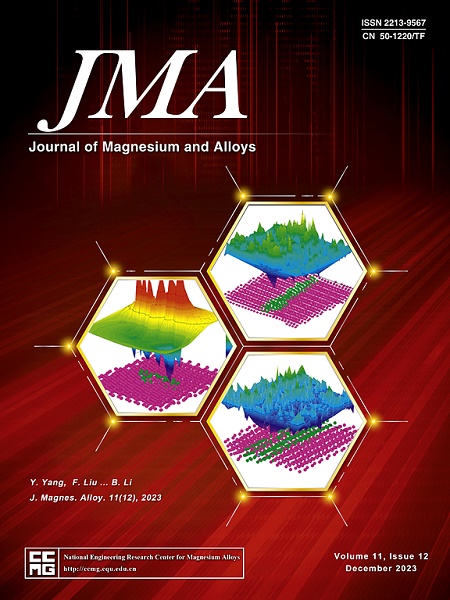Exploring the degradation behavior of biodegradable metals (Mg, Zn, and Fe) in human duodenal fluid
IF 15.8
1区 材料科学
Q1 METALLURGY & METALLURGICAL ENGINEERING
引用次数: 0
Abstract
Biodegradable metals have been of great interest in making gastrointestinal implants these years. The most researched biodegradable metal is magnesium (Mg), followed by zinc (Zn) and iron (Fe). However, due to the limitations of in vivo experiments and the complex component of the gastrointestinal fluid, their degradation mechanisms in such an environment are still ambiguous. In this work, the human duodenal fluid (HDF) was used to investigate their in vitro degradation behaviors, with a simulated duodenal fluid (SDF) prepared for the control group based on the HDF ionic composition. After immersion of these metals for 7 days, it is found that HDF shows a stronger pH buffering effect than SDF due to the presence of organics. These organics can also hinder the degradation of metals by affecting their product formation in different ways. On the one hand, the adsorption of organics and their effects on the fluid dominate their degradation inhibition effect on Mg and Zn in HDF. On the other hand, they can hinder the further oxidation of the degradation products of Fe, which is the main mechanism resulting in a lower degradation rate of Fe in HDF rather than in SDF. Among the three metals, Mg unsurprisingly shows the highest degradation rate in both fluids. Interestingly, Zn is nearly immune to degradation in HDF, while it presents typical pitting corrosion in SDF. Compared to their degradation rates in popular pseudo-humoral media (e. g. Hanks’ Balanced Salt Solutions, Dulbecco's modified Eagle's medium) reported previously, Mg degrades faster, and Zn and Fe more slowly in HDF. The higher in vitro degradation rate of Fe than that of Zn is influenced by oxygen and ions in the degradation environment.

探索生物可降解金属(Mg、Zn和Fe)在人十二指肠液中的降解行为
近年来,生物可降解金属在胃肠道植入物制造中引起了极大的兴趣。研究最多的可生物降解金属是镁(Mg),其次是锌(Zn)和铁(Fe)。然而,由于体内实验的限制和胃肠道液体的复杂成分,它们在这种环境下的降解机制仍然不明确。本研究采用人十二指肠液(HDF)研究其体外降解行为,并根据HDF的离子组成制备模拟十二指肠液(SDF)作为对照组。这些金属浸泡7天后,发现由于有机物的存在,HDF比SDF表现出更强的pH缓冲作用。这些有机物还可以通过以不同的方式影响金属的产物形成,从而阻碍金属的降解。一方面,有机物的吸附及其对流体的影响主导了它们对HDF中Mg和Zn的降解抑制作用。另一方面,它们会阻碍铁的降解产物进一步氧化,这是导致铁在HDF中的降解率低于在SDF中的降解率的主要机制。在这三种金属中,Mg在两种流体中的降解率最高。有趣的是,Zn在HDF中几乎不受降解,而在SDF中表现出典型的点蚀。与之前报道的在流行的伪体液介质(如Hanks’s Balanced Salt Solutions, Dulbecco’s modified Eagle’s medium)中的降解率相比,Mg在HDF中的降解速度更快,而Zn和Fe在HDF中的降解速度更慢。铁的体外降解率高于锌的体外降解率受降解环境中氧和离子的影响。
本文章由计算机程序翻译,如有差异,请以英文原文为准。
求助全文
约1分钟内获得全文
求助全文
来源期刊

Journal of Magnesium and Alloys
Engineering-Mechanics of Materials
CiteScore
20.20
自引率
14.80%
发文量
52
审稿时长
59 days
期刊介绍:
The Journal of Magnesium and Alloys serves as a global platform for both theoretical and experimental studies in magnesium science and engineering. It welcomes submissions investigating various scientific and engineering factors impacting the metallurgy, processing, microstructure, properties, and applications of magnesium and alloys. The journal covers all aspects of magnesium and alloy research, including raw materials, alloy casting, extrusion and deformation, corrosion and surface treatment, joining and machining, simulation and modeling, microstructure evolution and mechanical properties, new alloy development, magnesium-based composites, bio-materials and energy materials, applications, and recycling.
 求助内容:
求助内容: 应助结果提醒方式:
应助结果提醒方式:


